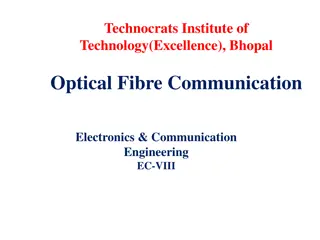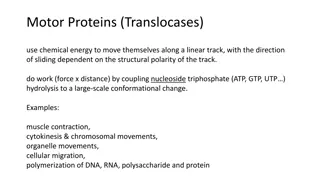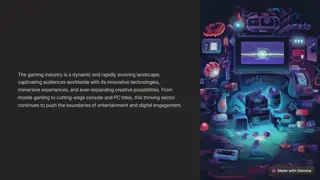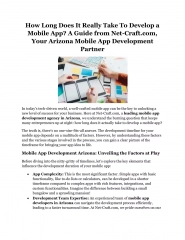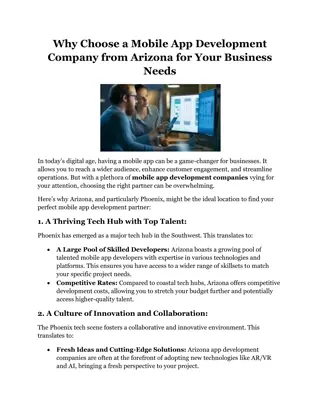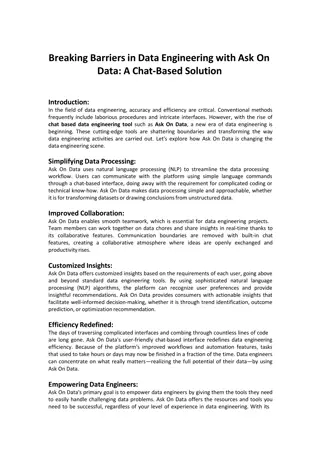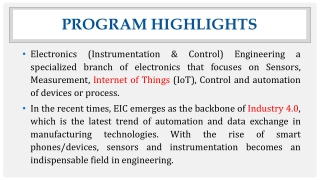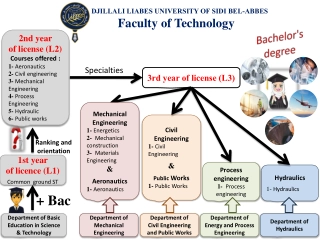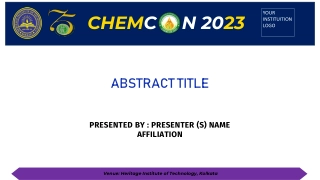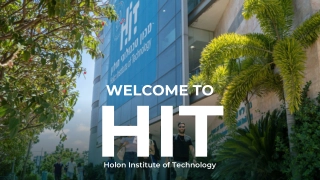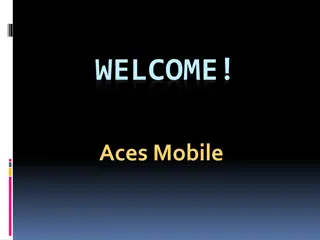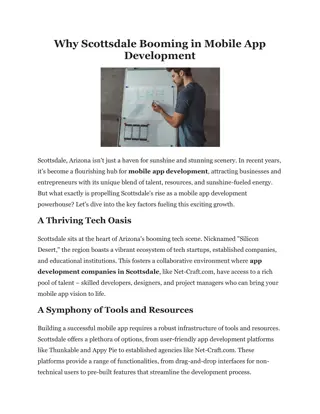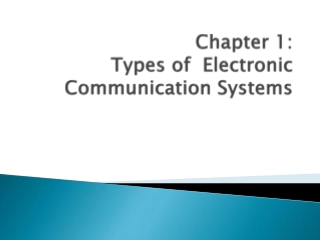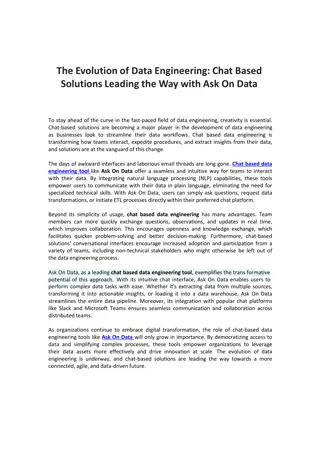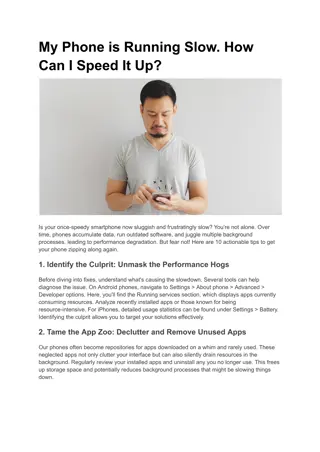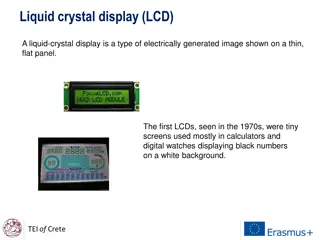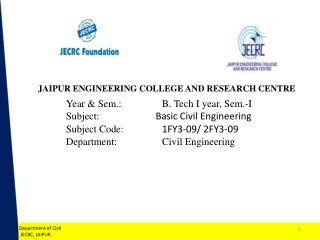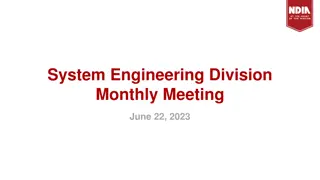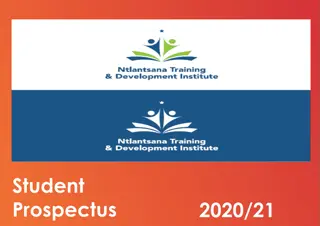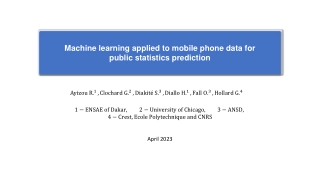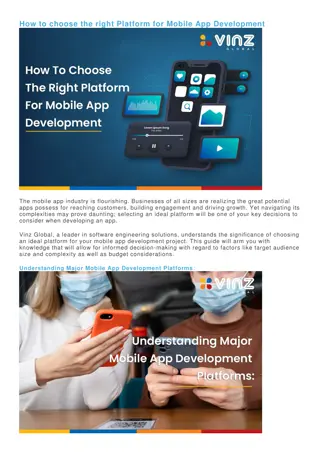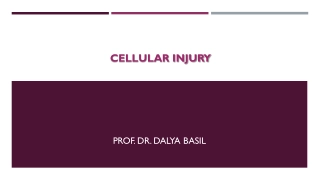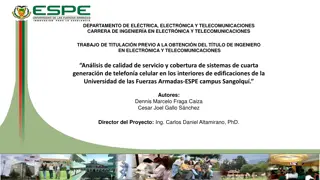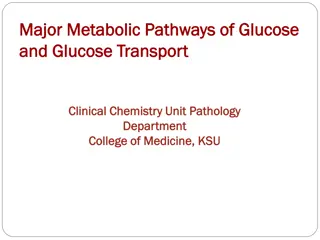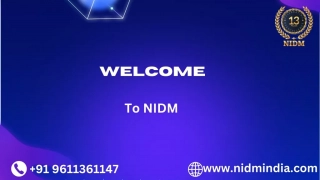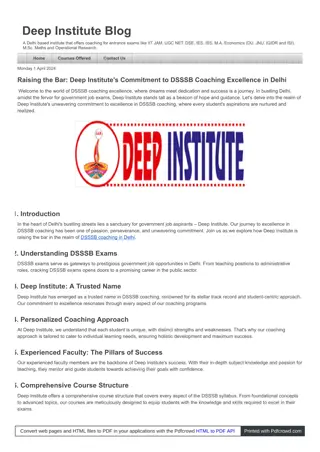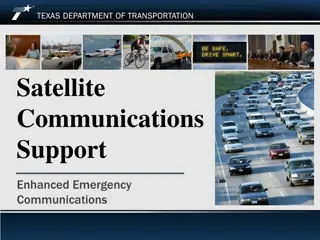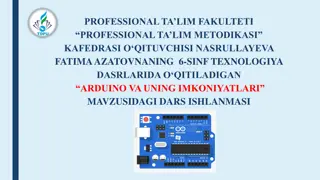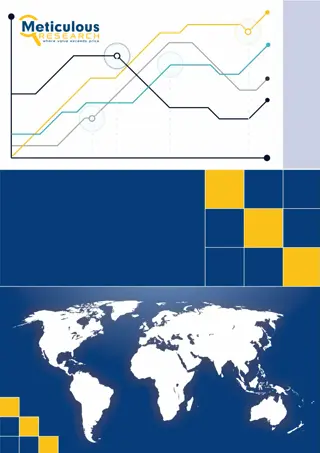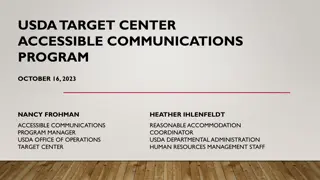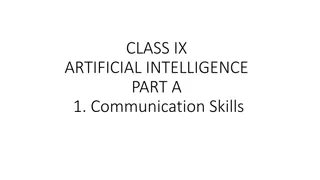Cellular Mobile Communication in Electronics & Communication Engineering - Technocrats Institute of Technology
Explore the introductory session on Cellular Mobile Communication at Technocrats Institute of Technology, Bhopal. Learn about the limited service capability, poor service performance, and inefficient frequency spectrum utilization in conventional mobile telephone systems. Gain insights into performance criteria for voice and service quality in commercial communication systems.
Cellular Mobile Communication in Electronics & Communication Engineering - Technocrats Institute of Technology
PowerPoint presentation about 'Cellular Mobile Communication in Electronics & Communication Engineering - Technocrats Institute of Technology'. This presentation describes the topic on Explore the introductory session on Cellular Mobile Communication at Technocrats Institute of Technology, Bhopal. Learn about the limited service capability, poor service performance, and inefficient frequency spectrum utilization in conventional mobile telephone systems. Gain insights into performance criteria for voice and service quality in commercial communication systems.. Download this presentation absolutely free.
Presentation Transcript
Technocrats Institute of Technology (Excellence), Bhopal Cellular Mobile Communication (EC-602) Unit 1 Session 1/4 Electronics & Communication Engineering VI Dr. Jitendra P S Mathur, AP, EC, TIT Technocrats Institute of Technology, Bhopal - 462021 MP, India Phone : +91-755-2751679 e-mail: info@titbhopal.net | website: www.titbhopal.net
Technocrats Institute of Technology (Excellence), Bhopal UNIT-1 Introduction to Cellular Mobile System (1) Limited service capability: Specific frequency allocation for use in autonomous geographic zones. The coverage area of each zone is planned to be as large as possible, which results in high transmitted power. The user need to reinitiate the call when moving into a new zone because the call will be dropped (i.e. no auto handoff). One frequency per channel and the number of active users is limited to the number of channels assigned to a particular frequency zone. (2) Poor service performance: The blocking probability is high during busy hours in conventional mobile telephone systems, to overcome this high-capacity system for mobile telephones was needed. <CMC> | <Unit-1> | <Session-01> 2
Technocrats Institute of Technology (Excellence), Bhopal (3) Inefficient frequency spectrum utilization: In conventional system each channel can only serve one customer at a time in a whole area which results inefficient utilization of spectrum. A basic analog cellular system , consists of three subsystems: a mobile unit, a cell site, and a mobile telephone switching office (MTSO), as Figure shows, with connections to link the three subsystems. Mobile units. A mobile telephone unit contains a control unit, a transceiver, and an antenna system. Cell site. The cell site provides interface between the MTSO and the mobile units. It has a control unit, radio cabinets, antennas, a power plant, and data terminals. MTSO: The switching office, the central coordinating element for all cell sites, contains the cellular processor and cellular switch. It interfaces with telephone company zone offices, controls call processing, provides operation and maintenance, and handles billing activities. Connections: The radio and high-speed data links connect the three subsystems. Each mobile unit can only use one channel at a time. <CMC> | <Unit-1> | <Session-1> 3
Technocrats Institute of Technology (Excellence), Bhopal <CMC> <Unit-1> | <Session-2> 4
Technocrats Institute of Technology (Excellence), Bhopal Performance Criteria There are three categories for specifying performance criteria. (1) Voice quality: For commercial communications system, a set value x at which y percent of customers rate the system voice quality (from transmitter to receiver) and circuit merits as follows: CM5 excellent (speech perfectly understandable) CM4 good (speech easily understandable, some noise) CM3 fair (speech understandable with a slight effort, occasional repetitions needed) CM2 poor (speech understandable only with considerable effort, frequent repetitions needed) CM1 unusable (speech not understandable) (2) Service quality: The system should serve an area as large as possible, because of irregular terrain configurations, it is usually not practical to cover 100 percent of the area for two reasons: (i) The transmitted power would have to be very high to illuminate weak spots with sufficient reception, a significant added cost factor. (ii) Higher the transmitted power, harder it becomes to control interference. <CMC> | <Unit-1> | <Session-2> 5
Technocrats Institute of Technology (Excellence), Bhopal (3) Number of dropped calls. During Q calls in an hour, if a call is dropped and Q - 1 calls are completed, then the call drop rate is 1/Q. This drop rate must be kept low. A high drop rate could be caused by either coverage problems or handoff problems related to inadequate channel availability. Special features: System would like to provide as many special features as possible, such as call forwarding, call waiting, voice stored (VSR) box, automatic roaming, or navigation services. <CMC> | <Unit-1> | <Session-2> 6
Technocrats Institute of Technology (Excellence), Bhopal Planning of Cellular System 1. Frequency Reuse strategies Each cellular base station is allocated a group of radio channels within a small geographic area called a cell. By limiting the coverage area to within the boundary of the cell, the channel groups may be reused to cover different cells. Frequency reuse or frequency planning Seven groups of channel from A (X) to G. Footprint of a cell - actual radio coverage. 3. Hand-off Strategies When a mobile moves into a different cell while a conversation is in progress, the MSC automatically transfers the call to a new channel belonging to the new base station. Handoff operation identifying a new base station re-allocating the voice and control channels with the new base station <CMC> | <Unit-1> | <Session-3> 7
Technocrats Institute of Technology (Excellence), Bhopal 1. Concept of frequency Reuse Channels A radio channel consists of a pair of frequencies one for each direction of transmission that is used for full-duplex operation. Particular radio channels, say F1, used in one geographic zone to call a cell, say C1, with a coverage radius R can be used in another cell with the same coverage radius at a distance D away. <CMC> | <Unit1> | <Session-4> 8
Technocrats Institute of Technology (Excellence), Bhopal UNIT-2 (Lecture:01) Cell coverage for signal and traffic Mobile Point to Point Model The Lee point to point model predicts each local mean of the received signal strength at the mobile terminal based on the radio path between the base station and the mobile unit, and plots all the predicted local means along a path in a mobile cellular environment. The term is also used in computer networking and computer architecture to refer to a wire or other connection that links only two computers or circuits, as opposed to other network topologies such as buses or crossbar switches which can connect many communications devices. <CMC> | <Unit-2> | <Session-1> 9
Technocrats Institute of Technology (Excellence), Bhopal <CMC> | <Unit-2> | <Session-1> 10
Technocrats Institute of Technology (Excellence), Bhopal Signal reflections in flat and hilly terrain, effect of human made structures, phase difference between direct and reflected paths, constant standard deviation, straight line path loss slope, general formula for mobile propagation over water distance propagation . flat open area, near and long and Interference resulting from propagation over the water can be controlled if we know the cause. In general, the permittivity s Er of seawater and fresh water are the same, but the conductivities of seawater and fresh water are different. <CMC> | <Unit-2> | <Session-3> 11
Technocrats Institute of Technology (Excellence), Bhopal We recall that the only reflected wave we considered in the land mobile propagation is the one reflection point which is always very close to the mobile unit. We are now using the formula to find the field strength under the circumstances of a fixed point- to-point transmission and a land-mobile transmission over a water or flat open land condition. <CMC> | <Unit-2> | <Session-3> 12
Technocrats Institute of Technology (Excellence), Bhopal Effect of the Human-Made Structures. Because the terrain configuration of each city is different, and the human-made structure of each city is also unique. The way to factor out the effect due to the terrain configuration from the man-made structures is to work out a way to obtain the path loss curve for the area. The path loss curve obtained on virtually flat ground indicates the effects of the signal loss due to solely human- made structures. We may have to measure signal strengths at those high spots and also at the low spots surrounding the cell sites. <CMC> | <Unit-2> | <Session-4> 13
Technocrats Institute of Technology (Excellence), Bhopal <CMC> | <Unit-2> | <Session-4> 14
Technocrats Institute of Technology (Excellence), Bhopal <CMC> | <Unit-2> | <Session-4> 15
Technocrats Institute of Technology (Excellence), Bhopal UNIT-3 Co-channel interference reduction The parameter q is the co-channel interference reduction factor. When the ratio q increases, Co-channel interference decreases. Furthermore, the separation D in Eq. (2.6-1) is a function of KI and C/I D = f (KI ,C/I ) q = D/R where KI is the number of co-channel interfering cells in the first tier and C/I is the received carrier-to-interference ratio at the desired mobile receiver. <CMC> | <Unit-3> | <Session-1> 16
Technocrats Institute of Technology (Excellence), Bhopal <CMC> | <Unit-3> | <Session-1> 17
Technocrats Institute of Technology (Excellence), Bhopal In a fully equipped hexagonal-shaped cellular system, there are always six cochannel interfering cells. cells in the first tier, as shown in Fig. 2.15; that is, KI = 6. The maximum number of KI in the first tier can be shown as six (i.e., 2 D/D 6). Cochannel interference can be experienced both at the cell site and at mobile units in the center cell. If the interference is much greater, then the carrier-to-interference ratio C/I at the mobile units caused by the six interfering sites is (on the average) the same as the C/I received at the center cell site caused by interfering mobile units in the six cells. in the six cells. According to both the reciprocity theorem and the statistical summation of radio propagation, the two C/I values can be very close. Assume that the local noise is much less than the interference level and can be neglected. C/I then can be expressed as Where qk is the cochannel interference reduction factor with Kth cochannel interfering cell <CMC> | <Unit-3> | <Session-2> 18
Technocrats Institute of Technology (Excellence), Bhopal <CMC> | <Unit-3> | <Session-2> 19
Technocrats Institute of Technology (Excellence), Bhopal Co-channel measurement design of antenna system The worst case is at the location where the mobile unit would receive the weakest signal from its own cell site but strong interferences from all interfering cell sites. To prove that a K = 7 cell pattern does not provide a sufficient frequency reuse distance. <CMC> | <Unit-3> | <Session-3> 20
Technocrats Institute of Technology (Excellence), Bhopal <CMC> | <Unit-3> | <Session-3> 21
Technocrats Institute of Technology (Excellence), Bhopal <CMC> | <Unit-3> | <Session-4> 22
Technocrats Institute of Technology (Excellence), Bhopal Design of a Directional Antenna System Call traffic begins to increase. Use the frequency spectrum efficiently. Avoid increasing the number of cells. When K increases, the number of frequency channels assigned in a cell must become smaller The efficiency of applying the frequency reuse scheme decreases Instead of increasing k ,we use directional antennas to reduce co channel interference. <CMC> | <Unit-3> | <Session-5> 23
Technocrats Institute of Technology (Excellence), Bhopal UNIT-4 Frequency management and Channel Assignment Designating set-up channel sand voice channels (done by the FCC) Numbering the channels (done by the FCC), and Grouping the voice channels into subsets(done by each system according to its preference). Means the allocation of specific channels to cell sites and mobile units. A fixed channel set Cell site-long-term basis. During a call-Mobile unit-short term basis (handled by MTSO). Ideally channel assignment should be based on causing the least interference in the system. <CMC> | <Unit-4> | <Session-1> 24
Technocrats Institute of Technology (Excellence), Bhopal Numbering the Channels The total number of channels (January 1988) is 832. But most mobile units and systems are still operating on 666 channels. A channel consists of two frequency channel bandwidths, one in the low band one in the high band Two frequencies in channel 1 are 825.030 MHz (mobile transmit)and 870.030 MHz (cell-site transmit) The two frequencies in channel 666 are 844.98 MHz (mobile transmit)and 889.98 MHz (cell-site transmit) The 666 channels are divided into two groups: block A system block B system <CMC> | <Unit-4> | <Session-2> 25
Technocrats Institute of Technology (Excellence), Bhopal Frequency-management chart <CMC> | <Unit-4> | <Session-3> 26
Technocrats Institute of Technology (Excellence), Bhopal Numbering the Channels Each block has 333 channels The 42 set-up channels are assigned as follows. Channels 313 -333 block A Channels 334 -354 block B The voice channels are assigned as follows. Channels 1 -312 (312 voice channels) blockA Channels 355 -666 (312 voice channels) block B New additional spectrum allocation-10 additional 166 channels are assigned a 1 MHz is assigned below 825 MHz (or 870 MHz) Additional channels will be numbered upto 849MHz (or 894 MHz) and will then circle back The last channel number is 1023 (=210) There are no channels between channels 799 and 991. <CMC> | <Unit-4> | <Session-3> 27
Technocrats Institute of Technology (Excellence), Bhopal Spectrum Allocation <CMC> | <Unit-4> | <Session-4> 28
Technocrats Institute of Technology (Excellence), Bhopal Full Spectrum Allocation <CMC> | <Unit-4> | <Session-4> 29
Technocrats Institute of Technology (Excellence), Bhopal Difference between FCA and DCA Sr. No. Key Fixed Channel Allocation (FCA) Dynamic Channel Allocations (DCA) Channel Allocation Fixed number of channels or voice channels are alloted. Channels to be alloted are not fixed initially. 1 Blockage If all channels are occupied, then user call is blocked. If all channels are blocked, then Base Station(BS) requests more channels from Mobile Station Center(MSC). 2 Frequence Usage Frequency usage is very high being cell channels are seperated using minimum reuse distance. Frequency reuse is not maximum because of random channel allocation. 3 Tangible A hardware can be touched being a physical electronic device. No need to complex algorithm. Softwares being digital can be seen but cannot be touched. Algorithm to determine efficient channel availability is quite complex in DCA. 4 Algorithm 5 Cost FCA is cheaper than DCA. DCA is costly as real time computation needed. 6 Cell Allocation Once call is complete, channel remains with the cell. Once call is complete, channel is returned back to Mobile Station Center. Mobile Station Center has high signal load, and has more responsibilities. 7 MSC Mobile Station Center has less burden. 8 <CMC> | <Unit-4> | <Session-5> 30


